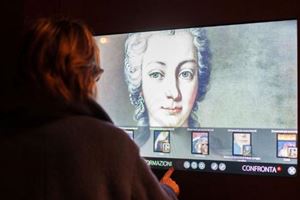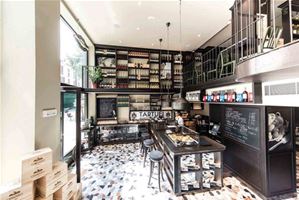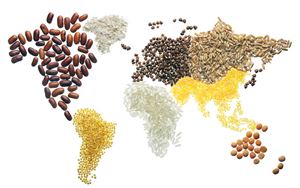Gary Radke is Dean’s Professor of the Humanities at Syracuse University, where he has taught since 1980. An expert in Italian medieval and Renaissance art, he is a fellow of the AmericanAcademy in Rome and has held fellowships from a number of private foundations. He organized the traveling exhibit The Gates of Paradise: Lorenzo Ghiberti’s Renaissance Masterpiece.
The exhibit Radke curated is the culmination of an extensive restoration of the gilded bronze doors of the Baptistery in Florence by Ghiberti (1378–1455). After more than 25 years of laborious effort by experts at Florence’s Opificio delle pietre dure, seven pieces, including thereof the famed panels, are in the United States for the first and only time since their creation more than 500 years ago. The tour began in Atlanta last October and will continue to Chicago, New York and Seattle. After that, the works will return to Florence, where they will be reassembled in their original bronze framework and placed in a hermetically sealed case in the Museo dell’Opera del Duomo, never to travel again.
Tell us about the exhibit touring the United States.
We have three of the major panels from the left door, which, as the curator of the exhibition, I chose specifically for the event. I think that if you are going to have an exhibition on the ‘Gates of Paradise’ and you want representative works, then you need to have these three. The Adam and Eve panel is probably the first that Ghiberti designed and modeled. The Jacob and Esau is renowned for its spectacular architecture and use of scientific perspective. It is one the best uses of perspective in relief sculpture. The third panel has scenes from the life of David. David is certainly the hero of Florentine biblical politics—the emblem, in some ways, of the city.
Why did you choose these panels ‘specifically’ for the traveling exhibit in the States?
My choice was based on subject matter, chronology and the different ways in which Ghiberti creates the illusion of three-dimensional space.
These three give a chronological range of his work on the doors. The Adam and Eve panel was the first, and most art historians believe that the David panel may have been the last he modeled. So these two give a sense of how Ghiberti thinks, develops, and rethinks his work over time.
Each panel shows a different way of creating a convincing effect in relief sculpture. In the Genesis panel, he made a spectacularly detailed rendition of trees and figures. Here Ghiberti works from three-dimensional figures down to the flattest, barely visible, relief forms. In the Jacob and Easu, his perspective and the architecture create the convincing effect.
Also, in Ghiberti’s own autobiography he himself says that he is very proud of the ‘Gates of Paradise’ because in many of the panels he uses hundreds of figures. The David panel shows how he figures out how to represent crowds, merging figures together rather than making them little individual dolls attached to the background. He thinks of large groups of people, and each person reacting within the crowd.
How do you feel personally as a scholar about the exhibit and about the doors themselves? What makes them so special?
Oh there is so much! I guess that the bottom line is that I am more impressed than ever with Ghiberti’s genius. I am more convinced that this is the masterpiece it is claimed to be.
And I am more impressed than ever with Ghiberti’s ability to work as a sculptor—I think this was the main revelation a lot of us had during our discussions. When you study these works, especially in the US, you have to study them from photographs, and thus, almost as if they were paintings. Though in reality, Ghiberti had to think and rethink how was he going to create these illusionist effects with sculpture, and not as a painter would do on a flat surface.
There is not a viewing position that Ghiberti did not think about in making the panels. In some cases, he had to distort figures: he flattened some and made other things more three-dimensional. The exhibition encourages and allows the viewer to appreciate this, because you can look at the panels up close and see them from all angles.
What was the most difficult part of being curator of the exhibit?
Being patient—these things do take so long. The other thing that was difficult was imagining how to tell the story of a work of art that is not a museum piece, but was made to be placed in the centre of Florence! The biggest challenge was how to make people understand that these are not museum pieces but that they are part of the lived experience of the city. Anyone who has seen the originals or the copies at the Baptistery knows this.
Michelangelo named the doors?
In the Middle Ages the space between the façade of the duomo and the Baptistery was known as Il Paradiso, because it was a burial place at the time. Michelangelo was quite clever and had a way with words, so I think that when he said ‘these are truly worthy of being the Gates of Paradise’, he was both referring to the fact that doors that opened on the Florentine Paradiso, but he was also saying that they are so splendid that they could be the Gates to Heaven themselves.
He was born later, so the doors were about 25 years old when he saw them. His comment does emphasize that these doors were and continue to be a great school for every Florentine or person of the arts. They are there 24 hours a day, seven days a week; they are in the centre of town, not in somebody’s private collection or in a museum. They are situated in the very place where the Renaissance was born—the very school of so many Renaissance artists.
How difficult was the restoration process?
The doors had be to be restored because the mercury gilding had become unstable. Salts and other materials had migrated behind the gold and set up an electrical charge that was beginning to blister the gold. The challenge was to stop that reaction, clean it off, yet not damage the gold.
Two processes can be used. A liquid bath technique (Rochelle salts and distilled water), is great if you have a panel that you can remove from the door. But Ghiberti made the door so well that pieces didn’t come out of the frame; they were wedged in perfectly! And you wouldn’t want to immerse the entire door: you might have some Rochelle salt residue. So the other technique was laser cleaning, which has been a miracle because it works on the surface with distilled water and basically vaporizes the encrustations. Laser technology was, in fact, pioneered on the Gates of Paradise—this was the first time it was used on a Renaissance bronze.
If you were in Florence now, what is the first thing you would do or see?
I would have a coffee! If it were winter, I would have a hot chocolate and sit in Piazza della Signoria. If it were summer, I would have a glass of Chianti and a panino with lardo di colonnata. These are always the first things I do when I am in Florence.







